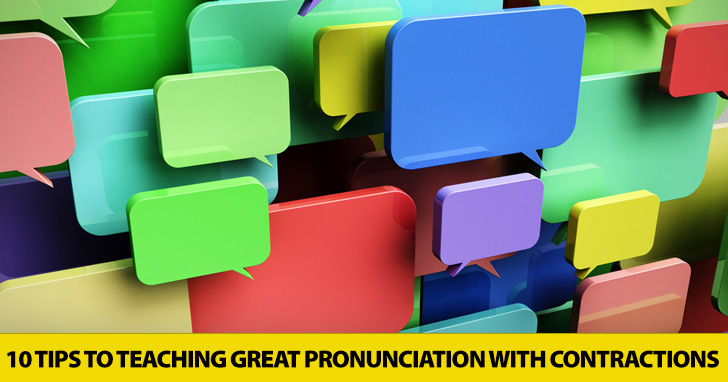Top 10 Tips for Teaching Pronunciation in ESL classes


Believe it or not, nonnative speakers whose English is nearly impeccable can still stand out because of their speech. Grammar, pronunciation, vocabulary…all of these can be perfect, but your students can still be pinned as second language learners. What’s the secret to sounding natural when speaking English? One of them is contractions. Contractions are grammatically simple – two words are shortened to become one new word with the same meaning. They are short, sweet, and to the point.
When you go to teach contractions, whether to beginning students or advanced ones, make sure you do it right. Here are ten simple tips to make that happen.Native speakers use contractions freely, but if your ESL students aren’t comfortable with contractions, their English will sound unnatural, even if their listeners can’t quite pinpoint what it is that’s off about their speech.

Before you go about teaching contractions, you may want to stress to your ESL students how important these small words are. While they can learn English grammar without recognizing and producing contractions, they will not be able to understand native speakers without recognizing and understanding these little words. Native speakers use contractions all the time, particularly in casual, everyday speech. Your students will have to master this skill in order to interact with native speakers on a daily basis.
Not only will your students have to understand contractions; they will have to use them as well. In order to sound like they are speaking English naturally, they will also have to master these unique blending of individual words. English as a second language speakers who do not use contractions often sound stilted in their language use and will stand out even if every other aspect of their spoken English is impeccable.
Make sure your students understand that contractions are words unique to themselves. Though they are the combination of two source words, contractions are not a fast pronunciation of those individual words. Because contractions are their own words, they have their own unique pronunciation, and you will need to point this out to your students. Too often ESL students don’t realize that contraction pronunciation is markedly different from that of its source words.
Contractions are not the same thing as elisions or linking together of words in English. They are also not the same thing as reductions. While more advanced students should study these other pronunciation patterns in English, even beginning students should take the time to learn and become comfortable with contractions and their correct pronunciation. If you notice your students slurring together two words which make up a contraction, point it out and revisit the correct pronunciation of the contraction.
Contractions or the lack thereof can change the meaning of a sentence. Native speakers will naturally use contractions, but on occasion they will choose NOT to use contractions. These choices are intentional and are laden with meaning. In such cases, the speaker is usually emphasizing something in the sentence. For example, I’m not hungry and I am not hungry, when spoken by a native speaker, have different connotations. Most likely, the latter speaker is being more insistive in his statement than the former or he is contradicting someone who has already spoken. If your students do not use contractions in their everyday speech, it is possible that their meaning will be misunderstood.
Teaching homophones when you teach contractions can help your students understand how contractions should be pronounced. Pointing out that they’re, there, and there are all pronounced identically will help students master pronunciation of contractions. In addition, teaching these homophones can help keep students clear on confusing grammar points. When you introduce contractions, take a minute or two to point out any homophones of the contractions, which is sure to help your students.
Teaching minimal pairs or rhyming words can also help students understand just how a contraction should be pronounced. You can show students how you’ve and groove vary only in the first consonant. Likewise, she’s and sneeze follow the same pattern. When students can see these minimal pairs and hear the differences between them, they are more likely to pronounce contractions correctly.
Use the phonetic alphabet when you are teaching contractions. Hopefully you use this great tool when you teach pronunciation of any kind in your ESL class, and students learning contractions will do well to know and use the phonetic alphabet as well. This system of writing down sounds in a word will take away confusion due to spelling and will help eliminate first language pronunciation biases.
When students struggle to hear the correct pronunciation of contractions, take a few minutes to point out how many syllables each word has. When you do, students who are slurring together words rather than pronouncing contractions correctly are likely to see their mistakes.
The use of apostrophes can be confusing to some ESL students. Make sure you point out that they are a punctuation mark and not a symbol or letter to be pronounced. They generally take the place of omitted letters, but these omitted letters do not affect the pronunciation of the contraction. Again, contractions are independent words with their own pronunciations and should not be a slurred together version of the two source words.
Whether your students are just beginning their English studies or are almost pros at grammar and pronunciation, it is worth taking some time to teach correct pronunciation of contractions. These tips will help you when you teach and will help your students say these little words the way they were meant to be said.